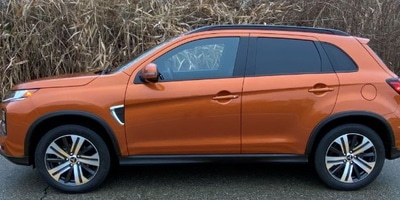A week spent in the new compact SUV from Mitsubishi
Pros:
Fuel economy
Exterior styling
Smooth shifter
Cons:
Underwhelming interior
Nickel rocket wheel covers
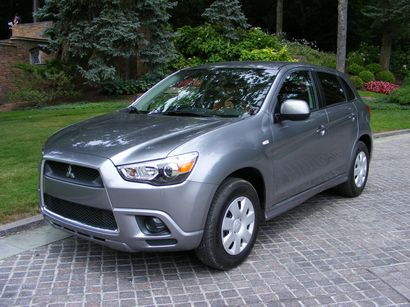
Good news and bad news
You have to wonder about Mitsubishi. The good news for 2011 is that sales are up by over sixty-six percent when compared to last year. In fact, the Outlander Sport was the third-best-selling model in the brand’s lineup in June. The bad news is that Mitsu still has a long way to go before it becomes a serious player in the U.S. market.
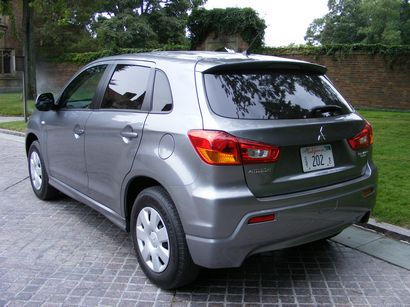
So with that last thought in mind, you’d think that the company would’ve gone all in when it decided to design a small SUV. The good news is that at least from the outside, their efforts have paid off. The bad news is that most of the good seems to stop there.

Models
The Mitsubishi Outlander Sport is available in two trims – the two-wheel drive base SE, available with either a five-speed manual or optional CVT automatic or the uplevel SE, sold only with the CVT but available in either two-wheel or 4-wheel drive configurations.
The only engine available is an all-aluminum 2-liter four-cylinder that produces an underwhelming (for its class) 148 horsepower and 145 lb.-ft. of torque.
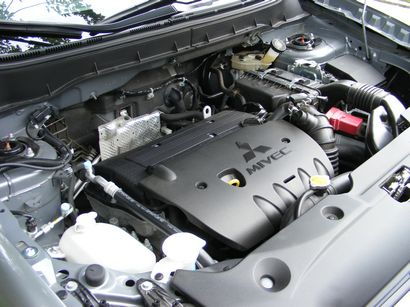
Standard safety features include stability and traction control, hill start assist, 4-wheel disc brakes with brake assist, ABS and EBD and seven airbags – including a driver knee airbag.
Equipment highlights include power windows, locks and heated mirrors as well as remote keyless entry, while air conditioning, audio system with CD/MP3 capability, RCA and audio input jacks as well as steering wheel-mounted cruise and audio controls are also part and parcel of all models.
Even our five-speed Mercury Gray ES came standard with Mitsubishi’s FUSE hands-free system which integrates the Outlander Sport with any Bluetooth-enabled phone.

Exterior
The exterior is the high point of the all-new Outlander Sport. Styling of its front end borrows heavily from the Lancer Evolution X and its “shark nose.”
Creases from both upper corners of the front grille continue back along the hood, tapering until they meet the trailing edge. The upper edge of the headlight bezels slants downward as it travels from the fenders to the grille, while a wide body-colored horizontal bar separates the upper and lower grilles.
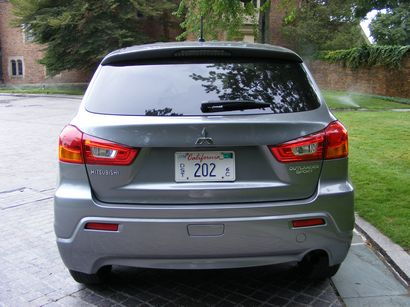
Both front fenders are softly flared, and a concave indentation beginning at the trailing edge of the wheel well flares extends along the side of the body, tapering and rising until it ends at the trailing edge of the rear doors.
In back, the taillamps mimic the headlamp enclosures, with their upper edges slanting downward, while a small lip spoiler extends across the trailing edge of the deck lid.
The one negative aspect of the exterior of our ES was the wheel covers – prompting me to wonder whether or not they had really come from Mitsubishi or had actually been ordered from a J.C. Whitney catalog.

Interior
Inside, fit and finish is excellent, with nice touches such as a leather-covered steering wheel and shift knob. All controls are within easy reach of the driver and work smoothly.
The headlight and turn signal stalk is located to the left of the steering wheel, while the right stalk controls the intermittent and speed functions of both the front and rear wipers.

The center stack is simple and straightforward. Buttons surrounding the CD slot control the media functions, while a set of three knobs above the center console control the HVAC system.
The front seats are very supportive, while the rear seats fold on a 60/40 split and, with both down, offer a rear storage area of 49.5 cubic feet that easily accommodates a mountain bike.
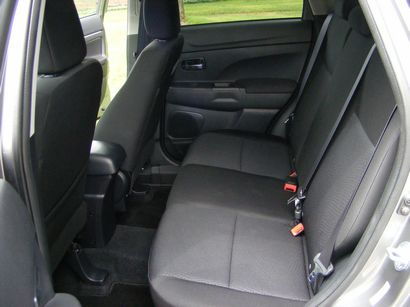
But all good things must come to an end and, unfortunately for the Outlander Sport, this is where it does.
Although the materials used inside are, for the most part, soft-touch, there’s way too much black plastic and none of it has been put together with much imagination. Without a sunroof or even contrasting shades of gray, the entire interior is dull-looking. Even the occasional brushed metal trim strips seem lost in the morass of differing shapes of black.
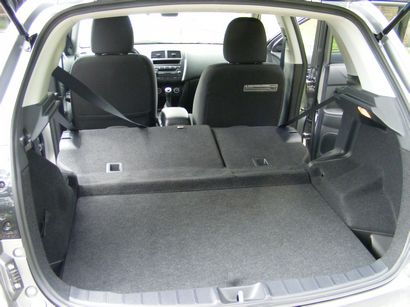
On the road
Mitsubishi has put a lot of effort into saving weight on the Outlander Sport. High-strength steel is used throughout the body and to save even more weight, the front fenders are fabricated out of plastic.
All this pays off as acceleration, no doubt aided by the 5-speed manual, is brisk for a vehicle of this type. Body roll is noticeable, but the Outlander Sport never pretends to be a Lancer Evolution. The Sport SE’s suspension offers just the right amount of compliance – not too harsh for around town driving, yet not too soft for freeway cruising.
Mitsubishi has also done a good job with the Outlander Sport’s electric steering – dialing in enough road feel and giving it just the right about of weight.
Fuel economy, as advertised, was excellent. Rated by the EPA as the best for a non-hybrid sport utility vehicle, according to the trip computer, I averaged 28.5 miles per gallon, in mixed city and freeway driving.

Pricing
New car dealer prices for the 2011 Outlander Sport top out at $29,205 for a 4WD SE with Premium, Exterior Sport, Navigation, Interior and LED Illumination packages.
Our 5-speed manual ES model had absolutely no options whatsoever and, including a $780 charge for destination and handling, had an MSRP of $19,275.
That price is roughly $2,400 less than a comparably-equipped Honda CR-V (which has 32 more horsepower) and $3000 less than a Toyota Rav4 (which also comes with 31 more horses and an additional 27 lb.-ft. of torque).
The problem is that price is just $415 more than the more spacious Hyundai Tucson (with 16 more horsepower) and $285 dollars more than the all-new and somewhat larger Kia Sportage (which comes with a 6-speed manual, 28 more horsepower and 23 more lb.-ft. of torque).
The biggest issue, however, is that each and every one of those competitive vehicles has a much better-looking interior than the Mitsubishi.
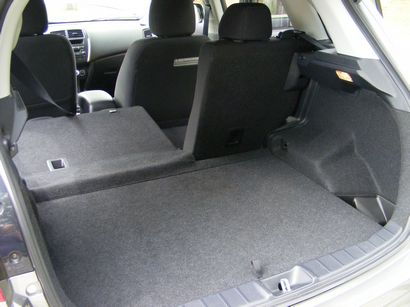
The Bottom Line
So what does this all mean?
What it means, in general, is that if you plan on being competitive in any vehicle segment, you have to bring your “A” game in executing all facets of vehicle engineering and design.
Unfortunately, the bottom line for Mitsubishi is this: Even though it gets great gas mileage and looks good on the outside, the Outlander Sport, particularly in SE trim, is a big disappointment where car owners spend all of their vehicle time – on the inside.





